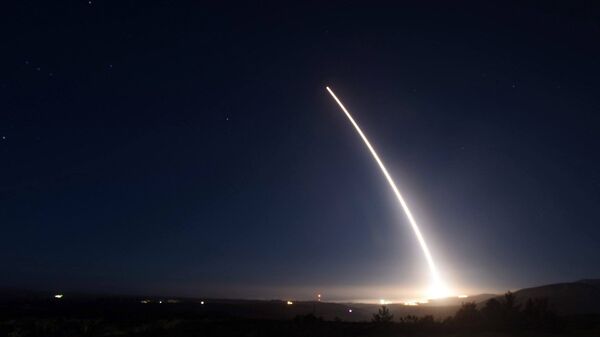The missile was fired from Vandenberg Air Force Base on the California coast and traveled 4,200 miles to the Kwajalein Atoll, located in the US Marshall Islands.
“These test launches verify the accuracy and reliability of the ICBM weapon system, providing valuable data to ensure a continued safe, secure and effective nuclear deterrent,” the Air Force said in a press release.
The Air Force released a video of the launch, showing the concrete protective doors of the missile silo slamming open and the 60-foot-long rocket blasting its way upward, as well as one of its rocket stages being shed once it’s well into the air.
“The flight test program demonstrates one part of the operational capability of the ICBM weapon system," Col. Omar Colbert, 576th Flight Test Squadron commander, said in the release. “The Minuteman III is nearly 50 years old, and continued test launches are essential in ensuring its reliability until the mid-2030s when the Ground Based Strategic Deterrent is fully in place. Most importantly, this visible message of national security serves to assure our partners and dissuade potential aggressors.”
However, the press release also notes that “test launches are not a response or reaction to world events or regional tensions.”
That said, the launch comes just hours after the Democratic People’s Republic of Korea test-fired two short-range missiles into the Sea of Japan, one of which landed in international waters less than 200 miles from the Japanese coast. That launch came just hours after the two sides confirmed denuclearization talks would soon resume.
Back in May, American and North Korean weapons tests also happened just minutes apart. It’s not simply serendipity, though: the US test launch calendars are planned years in advance, meaning Pyongyang might have been trying to prove a point by testing its own missiles at the same time the US does. Vandenberg AFB has public launch schedules posted for the next several months, but not years in advance, as the press release says.
A product of the Cold War nuclear standoff, the Minuteman III was first deployed in 1970 and designed for precision strikes, carrying several smaller warheads intended to destroy Soviet Union military facilities in the event of a nuclear exchange between the two countries. It was the first missile to carry multiple independent reentry vehicles (MIRV), able to lift three nuclear warheads, each with an explosive yield of 170 kilotons, or roughly 10 times the power of the bombs the United States used to destroy the Japanese cities of Hiroshima and Nagasaki in 1945.
The ICBM forms one third of the US’ nuclear triad, along with submarine-launched ballistic missiles and air-dropped gravity bombs. Together, they ensure Washington is able to respond to a nuclear attack of any size, part of an effective deterrence strategy grimly known as “mutually assured destruction.”
The Ground-Based Strategic Deterrent is a massive, $63 billion program designed to eventually replace the Minuteman system, and the Pentagon is exploring a variety of weapons for the project, including ballistic missiles and hypersonic cruise missiles. The US National Nuclear Safety Administration is also developing new gravity bombs, including ones designed to be used more easily in non-nuclear situations.


